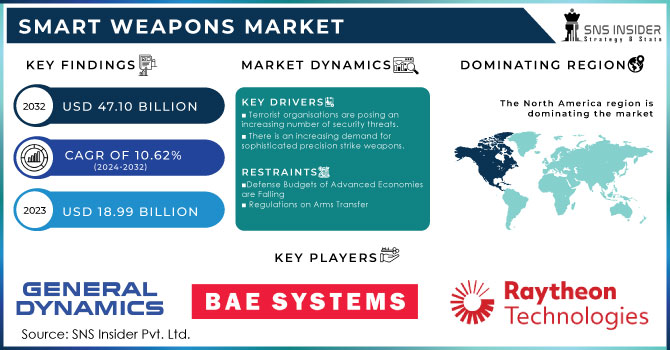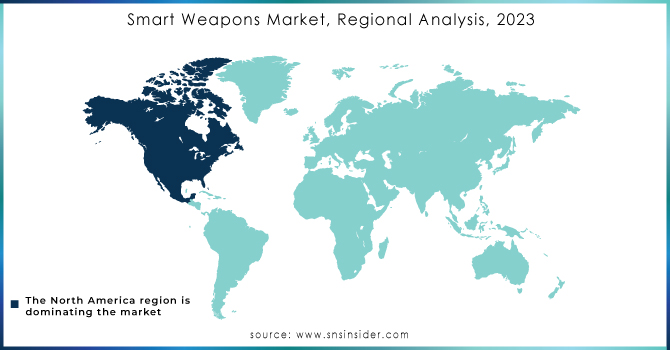Smart Weapons Market Report Scope & Overview:

To get more information on Smart Weapons Market - Request Free Sample Report
The Smart Weapons Market Size was valued at USD 18.99 billion in 2023 and is expected to reach USD 47.10 billion by 2032 with a growing CAGR of 10.62% over the forecast period 2024-2032.
A smart weapon is a military device that can hit a target with high accuracy using a control system. Smart weapons such as missiles or grenade launchers are usually equipped with a satellite, laser, or satellite navigation system. Smart weapons are different from smart weapons as smart weapons use control systems that rely on outside help, while smart weapons control themselves completely. A smart bomb with a laser-guided system is controlled by the pilot who directs the laser beam to the target. The beam is locked to the target with the help of a computer.
A bomb-set sensor helps detect laser light reflection. The bomb moves in its orbit with the help of a control computer, which pulls the moving wings to direct it. The television control system uses a television camera in the nose of the weapon to save the image of the target identified by the driver. Satellite guided bombs use precision computers to secure their purpose with the help of signals from roaming satellites and tail fines to adjust the direction of the bomb as it falls. Cruise arrows also use the information provided by navigating satellites to maintain their direction during flight.
MARKET DYNAMICS:
KEY DRIVERS:
-
Terrorist organisations are posing an increasing number of security threats.
-
There is an increasing demand for sophisticated precision strike weapons.
RESTRAINTS:
-
Defense Budgets of Advanced Economies are Falling
-
Regulations on Arms Transfer
CHALLENGES:
-
Weapon Integration is biggest challenge faced by the market.
OPPORTUNITIES:
-
Governments of major economies are increasing defence spending.
-
Rising Demand in Emerging Markets
THE IMPACT OF COVID-19
The impact of COVID-19 on the smart weapons business is unpredictable, and it is expected to be in effect for a few years.
The COVID-19 outbreak compelled governments around the world to impose strict lockdown and ban import-export of raw materials for the majority of 2020 and a few months in 2021. This resulted in a rapid decrease in the availability of critical raw ingredients for the manufacture of smart weapons.
Furthermore, the nationwide shutdown compelled smart weapons manufacturing facilities to shut down partially or fully.
The COVID-19 pandemic has caused widespread delays in efforts and initiatives related to the development of sophisticated smart weaponry.
The market is divided into five product categories: Missiles, Munitions, Guided Projectiles, Guided Rockets, and Directed Energy Weapons. Missiles are classified as anti-tank and standoff missiles, air-to-air and air-to-surface missiles, and anti-ship and anti-submarine missiles. Target Pods and Guided Bombs are examples of munitions. Because of the increasing demand for Advance Guided Missiles by various defence forces, the missiles category is likely to have a significant market presence.
The market is divided into three categories: air, naval, and land. Due to global cross-border tensions and rising defence investment by many economies, the land segment is predicted to have the biggest market presence throughout the CAGR period.
The market is divided into four technology segments: laser guidance, infrared guidance, radar guidance, and satellite guidance. Radars with Active Homing and Passive Homing are two types of radars. Radars with Infrared Homing and Imaging Infrared Homing are two types of radars. Because of its operational efficiency and high precision with which it can effect its goal, Laser-Guided technology is predicted to have a significant market presence during the projection period. Over the last ten years, modern military strategies have evolved rapidly. Both industrialized and developing countries are working on advanced missile systems with long range and high effectiveness
KEY MARKET SEGMENTATION
By Product
-
Missiles
-
Munitions
-
Guided Projectiles
-
Guided Rockets
-
Guided Firearms
-
Directed Energy Weapons
By Technology
-
Laser
-
Infrared
-
Radar
-
GPS
-
Others
By Platform
-
Air
-
Land
-
Naval
REGIONAL ANALYSIS
North America is made up of two large countries: the United States and Canada. North America leads the world in military spending and technology breakthroughs, and there is a huge demand for smart weaponry. Although Canada invests in the development of such advanced weaponry, the country's smart weapons business is mostly reliant on the United States.
The Asia-Pacific market is expected to develop the quickest during the forecast period, owing to rising defence spending in key economies. Due to increased investments in smart weaponry, major countries such as China, Japan, India, and Australia are driving market expansion in Asia-Pacific. Increasing military spending and escalating territorial conflicts among neighbouring countries such as China, South Korea, and North Korea are propelling the region's smart weapons market.

Need any customization research on Smart Weapons Market - Enquiry Now
REGIONAL COVERAGE:
-
North America
-
USA
-
Canada
-
Mexico
-
-
Europe
-
Germany
-
UK
-
France
-
Italy
-
Spain
-
The Netherlands
-
Rest of Europe
-
-
Asia-Pacific
-
Japan
-
south Korea
-
China
-
India
-
Australia
-
Rest of Asia-Pacific
-
-
The Middle East & Africa
-
Israel
-
UAE
-
South Africa
-
Rest of Middle East & Africa
-
-
Latin America
-
Brazil
-
Argentina
-
Rest of Latin America
-
KEY PLAYERS
The Key Players are Raytheon Company, Israel Aerospace Industries, L-3 Communications Ltd, and Northrop Grumman Corporation, Lockheed Martin, MBDA Inc., Orbital ATK, General Dynamics Corporation, BAE Systems, The Boeing Co.,Textron, Inc & Other Players
| Report Attributes | Details |
|---|---|
| Market Size in 2022 | US$ 18.99 Billion |
| Market Size by 2030 | US$ 47.10 Billion |
| CAGR | CAGR of 10.62% From 2024 to 2032 |
| Base Year | 2023 |
| Forecast Period | 2024-2032 |
| Historical Data | 2020-2022 |
| Report Scope & Coverage | Market Size, Segments Analysis, Competitive Landscape, Regional Analysis, DROC & SWOT Analysis, Forecast Outlook |
| Key Segments | • By platform (Air, Land, Naval) • By Technology (Laser, Infrared, Radar, GPS, Others), • By Product (Missiles, Munitions, Guided Projectile, Guided Rocket, Guided Firearms) |
| Regional Analysis/Coverage | North America (USA, Canada, Mexico), Europe (Germany, UK, France, Italy, Spain, Netherlands, Rest of Europe), Asia-Pacific (Japan, South Korea, China, India, Australia, Rest of Asia-Pacific), The Middle East & Africa (Israel, UAE, South Africa, Rest of Middle East & Africa), Latin America (Brazil, Argentina, Rest of Latin America) |
| Company Profiles | Raytheon Company, Israel Aerospace Industries, L-3 Communications Ltd, and Northrop Grumman Corporation, Lockheed Martin, MBDA Inc., Orbital ATK, General Dynamics Corporation, BAE Systems, The Boeing Co., and Textron, Inc. |
| DRIVERS | • Terrorist organisations are posing an increasing number of security threats. • There is an increasing demand for sophisticated precision strike weapons. |
| RESTRAINTS | • Defense Budgets of Advanced Economies are Falling • Regulations on Arms Transfer |

